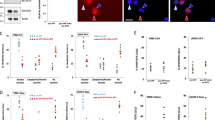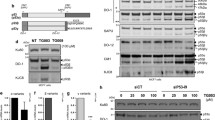Abstract
Livin (alternatively called ML-IAP or KIAP) is a cancer-associated member of the antiapoptotic inhibitor of apoptosis protein family. Two splicing variants of Livin, designated Livin α and Livin β, have been identified. The significance of these isoforms for Livin-mediated apoptosis inhibition is largely unclear. Using an isoform-specific RNA interference (RNAi) strategy, we silenced endogenous Livin expression in HeLa cells. We found that the targeted inhibition of Livin β, but not of Livin α, blocked the growth of HeLa cells in clonogenic survival assays. In addition, silencing of Livin β, but not of Livin α, sensitized HeLa cells to different proapoptotic stimuli such as UV irradiation, tumor necrosis factor α, or etoposide. These events were linked to activation of caspase-3 and increased poly(ADP-ribose) polymerase cleavage, specifically upon silencing of Livin β. The proapoptotic sensitization of HeLa cells upon RNAi-mediated silencing of the endogenous livin gene was specifically reverted by ectopic expression of Livin β but not of Livin α. We conclude that the Livin β isoform plays the key role for the antiapoptotic protection of HeLa cells by the livin gene. Our results show that the Livin isoforms can strongly differ in their functional significance for the antiapoptotic resistance of tumor cells. Studies evaluating Livin as a novel diagnostic and prognostic tumor marker should benefit from isoform-specific expression analyses.






Similar content being viewed by others
References
Hanahan D, Weinberg RA (2000) The hallmarks of cancer. Cell 100:57–70
Evan GI, Voudsen KH (2001) Proliferation, cell cycle and apoptosis in cancer. Nature 411:342–348
Igney FH, Krammer PH (2002) Death and anti-death: tumour resistance to apoptosis. Nat Rev Cancer 2:277–288
Schmitt CA (2003) Senescence, apoptosis and therapy—cutting the life-lines of cancer. Nat Rev Cancer 3:286–295
Salvesen GS, Duckett CS (2002) IAP proteins: blocking the road to death’s door. Nat Rev Mol Cell Biol 3:401–410
Liston P, Fong WG, Korneluk RG (2003) The inhibition of apoptosis: there is more to life than Bcl2. Oncogene 22:8568–8580
Vucic D, Stennicke HR, Pisabarro MT, Salvesen GS, Dixit VM (2000) ML-IAP, a novel inhibitor of apoptosis that is preferentially expressed in human melanomas. Curr Biol 10:1359–1366
Lin J-H, Deng G, Huang Q, Morser J (2000) KIAP, a novel member of the inhibitor of apoptosis protein family. Biochem Biophys Res Commun 279:820–831
Kasof GM, Gomes B (2001) Livin, a novel inhibitor of apoptosis protein family member. J Biol Chem 276:3238–3246
Ashhab Y, Alian A, Polliack A, Panet A, Ben Yehuda D (2001) Two splicing variants of a new inhibitor of apoptosis gene with different biological properties and tissue distribution pattern. FEBS Lett 495:56–60
Gazzaniga P, Gradilone A, Giuliani L, Gandini O, Silvestri I, Nofroni I, Saccani G, Frati L, Agliano AM (2003) Expression and prognostic significance of LIVIN, SURVIVIN and other apoptosis-related genes in the progression of superficial bladder cancer. Ann Oncol 14:85–90
Tanabe H, Yagihashi A, Tsuji N, Shijubo Y, Abe S, Watanabe N (2004) Expression of survivin mRNA and livin mRNA in non-small-cell lung cancer. Lung Cancer 46:299–304
Quiping Z, Jei X, Youxin J, Wei J, Chun L, Jin W, Qun W, Yan L, Chunsong H, Mingzhen Y, Quingping G, Kejian Z, Zhimin S, Qun L, Junyan L, Jinquan T (2004) CC chemokine ligand 25 enhances resistance to apoptosis in CD4+ T cells from patients with T-cell lineage acute and chronic lymphocytic leukemia by means of livin activation. Cancer Res 64:7579–7587
Yagihashi A, Asanuma K, Tsuji N, Torigoe T, Sato N, Hirata K, Watanabe N (2003) Detection of anti-livin antibody in gastrointestinal cancer patients. Clin Chem 49:1206–1208
Yagihashi A, Asanuma K, Kobayashi D, Tsuji N, Shijubo Y, Abe S, Hirohashi Y, Torigoe T, Sato N, Watanabe N (2005) Detection of auto-antibodies to livin and survivin in sera from lung cancer patients. Lung Cancer 48:217–221
Yagihashi A, Ohmura T, Asanuma K, Kobayashi D, Tsuji N, Torigoe T, Sato N, Hirata K, Watanabe N (2005) Detection of auto-antibodies to survivin and livin in sera from patients with breast cancer. Clin Chim Acta 362(1–2):125–130
Crnkovic-Mertens I, Hoppe-Seyler F, Butz K (2003) Induction of apoptosis in tumor cells by siRNA-mediated silencing of the livin/ML-IAP/KIAP gene. Oncogene 22:8330–8336
Brummelkamp TR, Bernards R, Agami R (2002) A system for stable expression of short interfering RNAs in mammalian cells. Science 296:550–553
Chen C, Okayama H (1987) High-efficiency transformation of mammalian cells by plasmid DNA. Mol Cell Biol 7:2745–2752
Southern PJ, Berg P (1982) Transformation of mammalian cells to antibiotic resistance with a bacterial gene under control of the SV40 early region promoter. J Mol Appl Genet 1:327–341
Butz K, Whitaker N, Denk C, Ullmann A, Geisen C, Hoppe-Seyler F (1999) Induction of the p53-target gene GADD45 in HPV-positive cancer cells. Oncogene 18:2381–23816
Butz K, Ristriani T, Hengstermann A, Denk C, Scheffner M, Hoppe-Seyler F (2003) siRNA targeting of the viral E6 oncogene efficiently kills human papillomavirus-positive cancer cells. Oncogene 22:5938–5945
Vucic D, Franklin MC, Wallweber HJA, Das K, Eckelman BP, Shin H, Elliott LO, Kadkhodayan S, Deshayes K, Salvesen GS, Fairbrother W (2005) Engineering ML-IAP to produce an extraordinarily potent caspase 9 inhibitor: implications for Smac-dependent anti-apoptotic activity of ML-IAP. Biochem J 385:11–20
Fulda S, Wick W, Weller M, Debatin K-M (2002) Smac agonists sensitize for Apo2L/TRAIL- or anticancer drug-induced apoptosis and induce regression of malignant glioma in vivo. Nat Med 8:808–815
Altieri DC (2003) Validating survivin as a cancer therapeutic target. Nat Rev Cancer 3:46–54
Mahotka C, Wenzel M, Springer E, Gabbert HE, Gerharz CD (1999) Survivin-ΔEx3 and survivin-2B: two novel splice variants of the apoptosis inhibitor survivin with different antiapoptotic properties. Cancer Res 59:6097–6102
Badran A, Yoshida A, Ishikawa K, Goi T, Yamaguchi A, Ueda T, Inuzuka M (2004) Identification of a novel splice variant of the human anti-apoptosis gene survivin. Biochem Biophys Res Commun 314:902–907
Caldas H, Honsey LE, Altura RA (2005) Survivin 2alpha: a novel Survivin splice variant expressed in human malignancies. Mol Cancer 4:11–20
Krieg A, Mahotka C, Krieg T, Grabsch H, Muller W, Takeno S, Suschek CV, Heydthausen M, Gabbet HE, Gerharz CD (2002) Expression of different survivin variants in gastric carcinomas: first clues to a role of survivin-2B in tumour progression. Br J Cancer 86:737–743
Meng H, Lu C, Mabuchi H, Tanigawy N (2004) Prognostic significance and different properties of survivin splicing variants in gastric cancer. Cancer Lett 216:147–155
Taubert H, Kappler M, Bache M, Bartel F, Köhler T, Lautenschläger C, Blümke K, Würl P, Schmidt H, Meye A, Hauptmann S (2005) Elevated expression of survivin-splice variants predicts a poor outcome for soft-tissue sarcomas patients. Oncogene 24:5258–5261
Fields S, Sternglanz R (1994) The two-hybrid system: an assay for protein–protein interactions. Trends Genet 10:286–292
Vucic D, Deshayes K, Ackerly H, Pisabarro MT, Kadkhodayan S, Fairbrother WJ, Dixit VM (2002) SMAC negatively regulates the anti-apoptotic activity of melanoma inhibitor of apoptosis (ML-IAP). J Biol Chem 277:12275–12279
Yang QH, Church-Hajduk R, Ren J, Newton ML, Du C (2003) Omi/HtrA2 catalytic cleavage of inhibitor of apoptosis (IAP) irreversibly inactivates IAPs and facilitates caspase activity in apoptosis. Genes Dev 17:1487–1496
Sanna MG, da Silva Correia J, Ducrey O, Lee J, Nomoto K, Schrantz N, Deveraux QL, Ulevitch RJ (2002) IAP suppression of apoptosis involves distinct mechanisms: the TAK1/JNK1 signalling cascade and caspases inhibition. Mol Cell Biol 22:1754–1766
Nachmias B, Ashhab Y, Bucholtz V, Drize O, Kadouri L, Lotem M, Peretz T, Mandelboim O, Ben Yehuda D (2003) Caspase-mediated cleavage converts livin from an antiapoptotic to a proapoptotic factor: implications for drug-resistant melanoma. Cancer Res 63:6340–6349
Acknowledgements
We thank Dr. X. Wang for the Smac expression vector. This work was supported by grants from the Wilhelm-Sander Stiftung (2001.052.2) and the Deutsche Krebshilfe (106213).
Author information
Authors and Affiliations
Corresponding author
Rights and permissions
About this article
Cite this article
Crnković-Mertens, I., Semzow, J., Hoppe-Seyler, F. et al. Isoform-specific silencing of the Livin gene by RNA interference defines Livin β as key mediator of apoptosis inhibition in HeLa cells. J Mol Med 84, 232–240 (2006). https://doi.org/10.1007/s00109-005-0021-5
Received:
Accepted:
Published:
Issue Date:
DOI: https://doi.org/10.1007/s00109-005-0021-5




